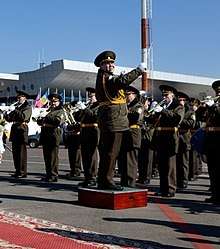Military band
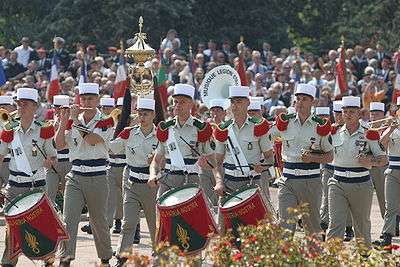
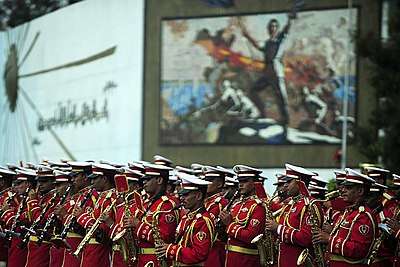
A military band is a group of personnel that performs musical duties for military functions, usually for the armed forces. A typical military band consists mostly of wind and percussion instruments. The conductor of a band commonly bears the title of Bandmaster or Director of Music. Ottoman military bands are thought to be the oldest variety of military marching bands in the world, dating from the 13th century.[1]
The military band should be capable of playing ceremonial and marching music, including the national anthems and patriotic songs of not only their own nation but others as well, both while stationary and as a marching band. Military bands also play a part in military funeral ceremonies.
There are two types of historical traditions in military bands. The first is military field music. This type of music includes bugles (or other natural instruments such as natural trumpets or natural horns), bagpipes, or fifes and almost always drums (see military drums). This type of music was used to control troops on the battlefield as well as for entertainment. Following the development of instruments such as the keyed trumpet or the saxhorn family of brass instruments, a second tradition of the brass and woodwind military band was formed.
Some police forces have their own police bands that provide similar function to a military band.
History
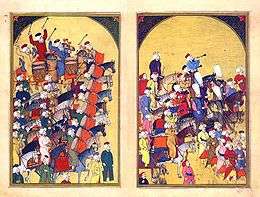
11th century book Divânu Lügati't-Türk mentions a prototype of the Mehtaran, as a "nevbet", Turkish military band tradition.[2] Bands were formed by soldiers.[3][4] 17th century traveler Evliya Çelebi noted that the Ottoman Empire had 40 guilds of musicians in the 1670s Istanbul.[5] Ottoman military bands influenced European equivalents.[6] Each regiment in the British Army maintained its own military band. Until 1749 bandsmen were civilians hired at the expense of the colonel commanding a regiment. Subsequently, they became regular enlisted men[7] who accompanied the unit on active service to provide morale enhancing music on the battlefield or, from the late nineteenth century on, to act as stretcher bearers. Instruments during the 18th century included fifes, drums, the oboe (hautbois), French horn, clarinet and bassoon. Drummers summoned men from their farms and ranches to muster for duty. In the chaotic environment of the battlefield, musical instruments were the only means of commanding the men to advance, stand or retire. In the mid 19th century each smaller unit had their own fifer and drummer, who sounded the daily routine. When units massed for battle a band of musicians was formed for the whole.[8]
United States
The American military band traditions date from the British era. From the American Revolutionary War onward military bands marched in the same manner as their French counterparts.
During the American Civil War most Union regiments had both types of groups within the unit. However, due to changes in military tactics by the end of World War I field musical had been mostly phased out in favor of the brass bands - themselves the basis for today's US civil brass band culture and traditions. These performed in a concert setting for entertainment, as well as continued to perform drill and martial events. In the United States, these bands were increased in instrumentation to include woodwinds, leading to the modern military band in the United States, and high school and college marching bands and concert bands.
Field music is also popular with many organizations such as police, fire, and veterans organizations, alongside living history groups, maintaining pipe and drum, fife and drum, or drum and bugle corps.
Russia
Starting in the late 17th century with the birth of the regular Russian armed services, each unit of the Imperial army and navy formed their own bands using regular enlisted personnel and NCOs and led by officers as directors of music and bandmasters. This tradition stayed even in the Soviet era, and one of the finest band conductors of that era was Major General Semyon Tchernetsky, who founded and became the first director of music of the Central Band of the Ministry of Defense of the Soviet Union from 1927 to 1951. Indeed, Russia has a long tradition of military bands and so many military marches have been composed by various composers through the years.
Today, military bands in the Russian Federation are also of the headquarters element from the regimental level onward, and also provide musical support to the different units of the Armed Forces of the Russian Federation, the Ministry of Internal Affairs, the Federal Protective Service, the Federal Security Service and the Ministry of Emergency Situations. The military bands here also provide musical support in civil and military events, in a wide range of groups and ensembles. Some can even continue the old Russian military band traditions by donning the old imperial military uniforms of the Russian Empire, especially the uniforms of the bands. Examples of such are the Central Band of the Ministry of Defence of the Russian Federation, the Exemplary Band of the Moscow Garrison Guard of Honor, the St. Petersburg Admiralty Band, the Central Band of the Western Military District and the Presidential Band from the Kremlin Regiment.
France
Since the 17th century, France has sported one of the oldest military band traditions in all of Western Europe, providing the Western world with a collection of French marches composed by eminent composers from the Ancien Régime, the Revolution, the Napoleonic era up to the present. Today's French Armed Forces bands are also of the headquarters element from the regimental or brigade level onward and can also provide musical elements for civil and military events. These bands are distinguished by their service dress uniforms.
Examples of such bands are of the Republican Guard, the Foreign Legion, the Army Armored Cavalry, Paratroopers and the Tropes de Marine. The French Navy also sports a distinctive Bagad playing in the bagpipe traditions of Brittany.
Functions and duties
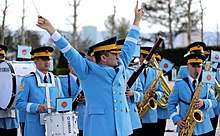
Military bands can vary in function and duties based on their specific mission. Bands may perform for a variety of reasons such as special events, military review, public relations or troop entertainment.
Military bands play ceremonial and marching music, including the national anthems and patriotic songs. A concert band's repertoire includes original wind compositions, arrangements of orchestral compositions, light music, popular tunes and concert marches found in standard repertoire. Modern-day military musicians often perform a variety of other styles of music in different ensembles, from chamber music to rock and roll. It is the same case in the other services as well.
Commonwealth of Nations
United Kingdom
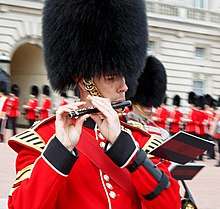
Since later medieval times and the formation of the first bands, the United Kingdom has had a strong military band tradition.
History
The oldest of all British military bands, is the Royal Artillery Band (see also Royal Artillery Mounted Band). The Band can trace its origins back to 1557 at the Battle of St. Quentin, although it was not made 'official' until 1762. A series of army reviews starting in 1994 reduced the number of British Army military bands from 69 to 22 bands.
All Regular Army Bands in the British Army are part of the Corps of Army Music and there are currently 22 Bands in service. These Bands range in personnel number from 64 to 15 and include: Traditional marching, mounted and concert bands, as well as rock bands and a small string orchestra.
The bands of the Corps of Army Music are:[9]
- The Band of The Household Cavalry - Hyde Park Barracks, London and Combermere Barracks Windsor
- The Band of the Royal Armoured Corps - Catterick, North Yorkshire
- The Royal Artillery Band - Tidworth
- The Band of the Corps of Royal Engineers - Chatham, Kent
- The Band of the Royal Corps of Signals - RAF Cosford, West midlands
- Band of the Grenadier Guards - Wellington Barracks, Central London
- Band of the Coldstream Guards - Wellington Barracks, Central London
- Band of the Scots Guards - Wellington Barracks, Central London
- Band of the Irish Guards - Wellington Barracks, Central London
- Band of the Welsh Guards - Wellington Barracks, Central London
- The Band of The Royal Regiment of Scotland - Edinburgh
- The Band of The Queen's Division - RAF Henlow, Bedfordshire
- The Band of The King's Division - near Preston
- The Band of The Prince of Wales' Division - St Athan, South Wales
- The Band and Bugles of The Rifles - Winchester
- The Band of The Parachute Regiment - Colchester
- The Band of The Brigade of Gurkhas - Shorncliffe, near Folkestone
- The Band of the Army Air Corps - Colchester
- The Band and Corps of Drums of The Royal Logistic Corps - near Camberley
- The Band of the Corps of Royal Electrical and Mechanical Engineers - Catterick, North Yorkshire
- The Band of the Adjutant General's Corps - near Winchester
- The Countess of Wessex String Orchestra - Woolwich, London
The British Army also has 20 Reserve Military Bands located across the UK and Gibraltar:[10]
- Band of the Honourable Artillery Company
- Regimental Band (Inns of Court & City Yeomanry) of the Royal Yeomanry
- Lancashire Artillery Volunteers Band
- The Nottinghamshire Band of the Royal Engineers
- The (Northern) Band of the Royal Corps of Signals
- Lowland Band of the Royal Regiment of Scotland
- Highland Band of the Royal Regiment of Scotland
- Band of the Princess of Wales's Royal Regiment (Queen's and Royal Hampshires)
- Band of the Royal Regiment of Fusiliers
- Band of the Royal Anglian Regiment
- Volunteer Band of the Royal Gibraltar Regiment
- Band of The Royal Irish Regiment (27th (Inniskilling) 83rd and 87th and Ulster Defence Regiment)
- Band of the Royal Welsh - The only Brass Band in the Reserve Army
- Band of the Duke of Lancaster's Regiment (King's Lancashire and Border)
- Band of the Yorkshire Regiment (14th/15th, 19th & 33rd/76th Foot)
- The Band of The Mercian Regiment
- The Salamanca Band of The Rifles
- The Waterloo Band of The Rifles
- Band of the 150th (Yorkshire) Transport Regiment, Royal Logistic Corps
- Band of the Army Medical Services
The Royal Marines Band Service is, since 1950 and the disbandment of the Fleet Divisional Bands, the only remaining musical wing of the Royal Navy in service. It currently consists of six Bands. Without doubt, groups of musicians existed in the Service before 1767, when Royal Marines Divisional Bands were formed at the naval dockyard-bases of Chatham, Plymouth and Portsmouth and the naval gathering-point of Deal in the Downs, and Marine bands (along with professional bands paid for by captains) plus their respective corps of drums provided music on board ships before and during battles of the Napoleonic Wars (e.g. during the long sail into action at the Battle of Trafalgar).
At present, there are a total of five Royal Marine Bands and a Corps of Drums:
- Band of HM Royal Marines, Portsmouth (HMS Nelson)
- Band of HM Royal Marines, Plymouth (HMS Raleigh)
- Band of HM Royal Marines, Scotland (HMS Caledonia, Rosyth)
- Band of HM Royal Marines, HMS Collingwood (replacing the Band of Britannia Royal Naval College)
- Band of HM Royal Marines, Commando Training Centre Royal Marines
The Band of the Royal Marines School of Music in Portsmouth (The Training Band) brings the total number to six.
The Royal Air Force Music Services is the organization which provides military musical support to the Royal Air Force. Based at RAF Northolt (previously at RAF Uxbridge) and RAF Cranwell, it forms the central administration of one hundred and seventy musicians divided between the Central Band of the Royal Air Force, The Band of the Royal Air Force College, The Band of the Royal Air Force Regiment and Headquarters Music Services. These main military bands contain within their ranks the Royal Air Force Squadronnaires, Royal Air Force Swing Wing, Royal Air Force Shades of Blue, and The Salon Orchestra of the Central Band of the Royal Air Force.
In the United Kingdom, the Mounted Band of the Household Cavalry and Massed Bands of the Household Division perform at Trooping the Colour, an annual ceremony held every June on Horse Guards Parade to mark the official Queen's Birthday celebrations. The Massed Bands and the Mounted Band play a central role in this ceremony. The term "Massed Bands" denotes the formation of more than one separate band performing together, whether belonging to one or more regiments, or indeed countries.
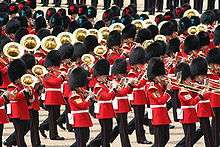
Military bands of the armed forces reserves and civil and youth military marching band traditions
The various volunteer reserve bands in the British Armed Forces' three services mirror those of the regular forces bands, as well as civil military styled marching bands (for example, The Royal British Legion, which maintains its own bands).
The various youth military uniformed services of the UK have their own bands using the very same formations mentioned earlier:
- The Army Cadet Force bands and the air cadet organisation bands in the UK under the banner of the Royal Air Force Air Cadets use the general formation used by the British Army and the RAF, but several RAF Air Cadet bands have drums at the front similar to the Royal Marines
- The RM/DYRMS formation is standard practice for Sea Cadet Corps (United Kingdom), Royal Marines Volunteer Cadet Corps and the Combined Cadet Force bands.
Uniformed organization-based and civil Corps of Drums mostly follow the format by most Army regiments while those with links to the light infantry do not use fifes at all. In the case of those that are part of the Sea Cadets and the RMVCC, they follow the RM (and former RN) Corps of Drums traditions, adding glockenspiels and in some bands wind and brass instruments.
The Liberty High School Grenadier Band in Bethlehem, Pennsylvania has been using the British General bands format since 1967, adapted and made suitable for the American high school marching bands with the addition of Sousaphones, Mellophones, Baritone horns and fewer trumpets. The LHSGB of about 300 is modeled after the Coldstream Guards with a bagpipe section modeled after the Scots Guards, a colour guard section, majorettes, fanfare trumpeters, and a drum major. This format is also used by several US high school bands found all over the country. The format used by the RM and the DYRMS is the formation used by the Valley Forge Military Academy and College Regimental Band in Wayne, Pennsylvania, led and staffed by retired RMBS personnel, and by the United States Merchant Marine Academy Regimental Band, also modeled on the Royal Marines bands. Another US military academy, the Missouri Military Academy, has its band modeled in the same manner as the RM.
British style brass bands have the same positioning as the British Army brass bands as they are composed of only brass instruments, saxhorns and percussion. The same applies to carnival band formations, though these have the option to include woodwinds.
Malaysia
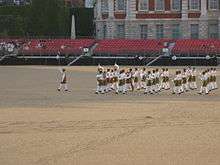
Malaysian military bands are led by the percussion (snare drums either slung or mounted, bass drums, single and multiple tenor drums, cymbals and sometimes glockenspiels), and followed by the brass and woodwinds (with the addition of trumpets, mellophones, marching baritone, contrabass bugles and sousaphones), following a formation format that is similar to the Royal Marines and French military bands, and inspired by its long cultural heritage in music.
Australia
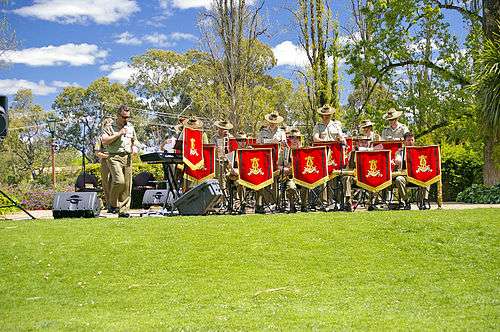
Australian Military bands, and their formations on ceremonies and parades, are derived from those of the United Kingdom, with each service - Royal Australian Navy, Australian Army and the Royal Australian Air Force - having their own approach, based on the service military bands in the UK. For example, the Royal Australian Navy Band marches with drums at the front, while the Royal Australian Air Force Band has its trombone section at the front (same format used by the Army). The instrumentation also varies from band to band, as does the size of the ensemble. The Royal Australian Navy Band maintains two sections of musicians, one based in Sydney and one near Melbourne (at H.M.A.S. Cerberus). The Australian Regular Army has full-time bands based in Canberra, Wagga Wagga, Sydney, Brisbane and Townsville, as well as part-time (Reserve) bands in Melbourne, Adelaide, Brisbane, Perth, Sydney, Newcastle, Hobart and Darwin. There are also many Reserve pipes and drums bands attached to various units. The Royal Australian Air Force Band consists of a single 43 piece band based in Melbourne. The bands of all three services perform at Ceremonial functions, such as Commemoration ceremonies and ANZAC Day marches, in addition to providing music capability for their respective services.
New Zealand
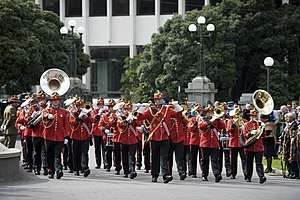
Military bands in New Zealand derive their formations from other Commonwealth, and US, bands. In 2012 nine of the existing twelve New Zealand military bands were disbanded for reasons of economy. A single full-time band is now retained for each of the three armed services.
Singapore
Until the 1990s the Singapore Armed Forces and Singapore Police Force band formations were similar to the Royal Marines Band Service, and Malaysian military bands. In the beginning of the 21st century this was changed to a format similar to British Army and Royal Air Force military bands.
Canada
Years of French and later British rule plus the influence of the United States made their imprint in the creation of the Canadian military band tradition. Today, the unique Canadian band culture is seen actively in the modest number of bands that serve the Canadian Armed Forces Band Branch. These bands serve the Canadian Army, Royal Canadian Navy and the Royal Canadian Air Force. Civil cadet groups affiliated to these use the formations similar to those in the UK and US.
United States
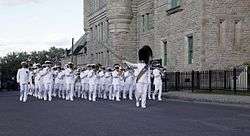
Ever since the American Revolution ended in 1781, American military bands march to the fast tempo of French military bands, owing to their fast marching pace as compared with the slow marching pace of British bands. The instrumental positioning, even though inspired by the British, is also a mix of other influences, including French and German influences. A uniquely American type of military band still remains to be the Ancient Fife and Drum Corps and only the Old Guard Fife and Drum Corps is the only band of this type. The US bugle bands are also the precursors of the modern day drum and bugle corps and the only one in active service today is that of the United States Marine Drum and Bugle Corps "The Commandant's Own". Moreover, another clear descendant are the civilian brass bands active all over the nation, tracing their heritage to the Civil War military brass bands.
The largest military marching band in the world is the "Fightin' Texas Aggie Band" of Texas A&M University. It is entirely composed of ROTC cadets from the university's Corps of Cadets[12] and subdivided into two bands: the Infantry and Artillery bands of the Corps.
France

France has a long established military band tradition. While modern instrumentation somewhat mirrors those of British and American military bands, it is based on uniquely French military music traditions. These bands are led by a conductor and a drum major.
There are four types of military bands today in France: military marching bands (subdivided into marching and mounted brass bands), Corps of Drums (only in the French Foreign Legion), Fanfare bands (attached to the marching band or as separate marching bands) and Pipe bands (more known in Brittany as the Bagad). Examples of these are the Marching, Fanfare, and Mounted Bands of the French Republican Guard, and the Central Band of the French Foreign Legion, the only remaining French military band to use the fife. The French Army Cavalry and Armored Branch maintain mounted and dismounted fanfare bands featuring cavalry trumpets and bugles plus kettledrums and marching percussion. Another example is the band of the French Chasseurs Alpins (the band of the 27th Mountain Infantry Brigade (France)), which uses the Alphorns in displays.
Italy
Italy has a long tradition of military music. Today, Italian military bands (called in the Italian language as both either banda or fanfara) even through have an instrumentation order similar to British, French and US military bands, retain the Italian musical favor and heritage.
Mounted bands in the Italian Army, Carabineri and the Polizia di Stato formerly used only the bugle and the natural trumpet from the 16th century, up to the middle of the 20th century, from the late 19th century till now also they use brass, woodwinds, timpani, single tenor drums, snare drums, cymbals and glockenspiels.
Brass bands belonging to the Bersaglieri have no percussion and march on the jogging pace of their attached units on the lead.
Spain

Military bands in Spain are of very long standing. There are reports of primitive bands dating from the Celtiberian tribal and Roman periods. However military music in the modern sense began with the expansion of the Spanish Empire between the sixteenth and eighteenth centuries, during the numerous Spanish military campaigns in Europe and the wider world, when the first bands were formed in the Tercios of the Spanish Army, equipped wuth fifes and drums and later with wind instruments of the period. The influence of Spanish military marching bands is very important, especially in Latin America and the Philippines. The characteristic marches are the "touch" of trumpets and horns, and the steady rhythm of drums, with contrasting festive spirit and martial beats.
Band formations in the Spanish Armed Forces follow the British model, but Spanish bands tend to have the most senior bandsmen or bandsman, playing a tuba, positioned at the head of the band or at the second line. He or she is usually the band sergeant major or the band corporal, mostly stationed in between the trombone players or leading a file of tuba and euphonium players in some bands. Bugle bands are part of the Spanish musical tradition since the 19th century, when the bugle replaced the fife in the Spanish Army and Navy, and these bands consist of drummers and buglers (or trumpeters in the cavalry dismounted bands since the 20th century). Such formations, when massed together, are led by a Director of Music and a Drum Major (with a Bugle Major or a Trumpet Major depending on the specialty arm). The century old Corps of Drums of the Regulares is led by a Drum Major and a Bugle Major with personnel playing snare, bass and single tenor drums, bugles, North African flutes and sometimes bagpipes, and the Spanish Royal Guard (as well as the 1st King's Immemorial Infantry Regiment of AHQ) sport Corps of Drums playing drums and fifes and wearing 18th century uniforms. Plain bugles, by tradition, are used in the bugle bands of the Spanish Legion and the Paratrooper Brigade instead of the valved bugles used by other bands and the trumpets and bass drum used by the Royal Guard's. Within units based in Galicia and Asturias, military pipe bands are in service as well.
Only the Civil Guard and the Royal Guard retain mounted bands with cavalry trumpeters with the latter also having a mounted kettledrummer.
Germany, Austria, South and Central America
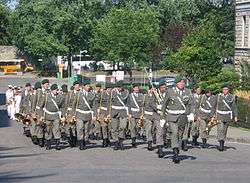
German (formerly East German) and Austrian (and South/Central American) military bands have two or more components depending on instrumentation. Military bands in Germany's Bundeswehr today are only composed of a Military band and a Corps of Drums (Austrian bands do not) while Military bands in Chile have the same instrumentation with added Bugles on the Corps of Drums, the same with those military bands from the Spanish-speaking South American countries, with a few unique additions. Argentine and Uruguayan military bands have field drummers and occasionally buglers and fifes (as is the case with the Tacuari Drummer military band of the Regiment of Patricians, which has two fifers) accompanying the main band while bands in Peru and Ecuador have the percussion on the front and the woodwinds and brass behind them, following French practice.
Other distinguishing features are the presence or absence of the Turkish crescent in the military bands when they are on parade and the band's conductor being assisted by a Drum major and in Chile and Mexico by a bugle major. Another key feature, seen in some military bands in Brazil and in the Pipe bands of the Colombian Navy's educational institutions (the Admiral Jose Prudencio Padilla Naval Academy and the Marine Basic School), is the presence of bagpipes in the bands, and as seen in the Marching Band of the Brazilian Marines, the use of more valved bugle types like baritones and mellophones. In Bolivia, the use of the Turkish crescent with the addition of vertical banners and standards is standard practice in its military bands (only the Bolivian Navy fields bagpipers and fanfare trumpeters in its bands, the latter being the case of the band of the Bolivian Colorados Regiment which uses them).
In types of ensemble, these bands are called as:
- Corps of Drums (Spielmanszug, Tambourkorps, Trommlerkorps, Banda de Guerra, Banda Marcial, Banda Musico Marcial/Tradicional Marcial (in Colombia), Peloton Comando (in Ecuador))
- Military/Music/Marching Band (Musikkorps, Musikkappele, Orchester, Banda de Musico/Musica, Banda Militar, Banda Marcial (in Brazil and Venezuela), Banda instrumental)
- Drum and bugle bands (Banda de Guerra, Spanish for War band, in Mexico)
- Brass bands (Blasorchester, Blaskappelle)
- Fanfare bands (Fanfarenzug, Fanfarenkorps)
- Mounted bands (Trompeterkorps, Kavalleriemusik, Kavallerieorchester, Kavallerie Fanfare, Fanfarekavalleriekorps, Banda Montada, Fanfarria Militar)
Such bands are led by Drum Majors, Conductors/Directors of Music and Bugle Majors in the case of mounted, bugle and fanfare bands.
Argentina
Argentina has longstanding connections with Germany, and their army bands reflect these traditional links.
At the beginning of the 20th century, there was an exchange of marches between the Imperial German Army and the Argentinean Army: Germans gave Argentinians Alte Kameraden, while Argentinians gave Germans the Marcha de San Lorenzo, which was used in 1940 during the victory parade on the Champs Elysées following the defeat of France.
Three bands belong to the oldest cavalry, artillery and infantry regiments of the Argentine Army, use band formations modeled on German and Italian traditions.
- The Alto Peru Fanfare Band of the Argentine Regiment of Mounted Grenadiers is an all-brass mounted band using the same brass and percussion instruments mentioned above. The ceremonial uniform design dates from 1813, and this band serves the President of Argentina. .
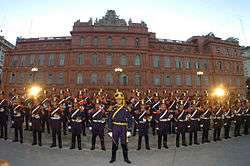 Alto Peru Fanfare Band
Alto Peru Fanfare Band - The Tambor de Tacuari Band is the "Regiment of Patricians's regimental band. This regiment is the oldest and most prestigious Argentinean infantry regiment. Musicians wear the 1806 regulation uniform originally worn by the regiment, when it was raised in response to the British attack on Buenos Aires. The Patricios formally represent the Federal Capital as its honor band.

- The Ituzaingó Band of the 1st Artillery Regiment "Brigadier General Tomas de Iriarte" is the official honor band of the Argentine Ministry of Defense. The band wears uniforms worn by Argentine gunners during the Argentina-Brazil War and later conflicts, with pith helmets as headdress.
Another notable band of the Argentinian Army is the Mounted Band of the 4th Armoured Cavalry Regiment "General Lavalle's Cuirassiers". They wear uniforms similar to those of the French Republican Guard Cavalry and 19th century cuirassier units. This band uses the same brass and percussion instruments mentioned above, when either mounted or dismounted. Other bands in the Army include:
- Band of the Colegio Militar de la Nación
- Band of the Army NCO School "Sergeant Cabral"
- Band of the General Jose de San Martin Military Academy
- Band of the General Manuel Belgrano Military Academy
- Band of the 16th Infantry Regiment "Andes Rifles"
- Band of the 10th Armored Cavalry Regiment "Pueyrredón Hussars"
- Band of the 6th Armored Cavalry Regiment "Blandengues"
- Band of the 5th Light Cavalry Regiment "General Martin de Güemes"
- Band of the 22nd Mountain Infantry Regiment "Lieutenant Colonel Juan Manuel Cabot"
The Argentine Navy fields the Navy Staff Band, the Band of the Argentine Naval Academy and the Band of the Argentine Navy NCO School. Representing the Argentine Air Force are the Band of the Argentine Air Force Academy, the Band of the Argentine Air Force NCO Academy and the 1st Air Brigade Band.
Peru
Examples of Peruvian bands include the Mounted Fanfare Band Company of the Presidential Life Guard Dragoons Regiment "Marshal Domingo Nieto" and the Band of the Chorrillos Military School of the Peruvian Army and the Casma Cadet Band of the Peruvian Naval School, Peruvian Navy. These bands follow the Spanish and French practice - but with drums out front following the French model. The PLGDR Band is also the only mounted band in active service within the Armed Forces.
Another example is the Lima Air Region Band of the Peruvian Air Force.
Until 1988 the Band of the Peruvian Republican Guard provided music during state ceremonies, although it belonged to the Ministry of the Interior. The military styled band of the National Police of Peru continues its heritage together with the bands of the Civil Guard and the Investigations Police.
Chile
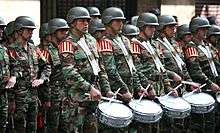
Two Chilean mounted bands are of high interest: the Mounted Band and Bugles of the 1st Cavalry Regiment "Grenadiers" and the Band and Bugles of the 3rd Cavalry Regiment "Hussars" of the Chilean Army. Other bands include the band of the Army NCO School and the Bernardo O'Higgins Military Academy, also of the Chilean Army, the Band of the Arturo Prat Naval School of the Chilean Navy and the Central Band of the Carabineros de Chile. Band formations on parade, mounted bands included, follow the German model, however only the Chilean Air Force Symphonic Band does not participate - the service is represented on parade by the Bands of the Captain Manuel Avalos Prado Air Force Academy and the Air Forces Specialities School. Another band formation and one with increasing public awareness is the military band of the Chilean Gendarmerie, which reports to the Ministry of Justice.
Uruguay
The Mounted Band of the 1st Cavalry Regiment "José Gervasio Artigas's Own Blandengues Horse Guards" of the Uruguayan Army is a mounted band following the Argentine practice, wearing the regiment's 19th century uniforms, but unlike its Argentine counterpart, also uses woodwinds. Another example is that of the Army's 1st Infantry Brigade Band, the official honors band of the General Assembly of Uruguay, which sports dress uniforms worn during the Argentina-Brazil War and later conflicts. Bands are also mounted by the Army's Uruguayan Military School and the General Artigas Military High School, the latter having recently reinstated the use of the bugle for its field section, the only band to do so. The Air Force Band is the only one that uses the shoulder mounted snares and the multiple tenor drum.
The National Navy of Uruguay maintains for ceremonial purposes the Band of the Uruguayan Naval Academy, which doubles as the official band of the service.
Ecuador
The Mounted Band of the Ecuadorian National Police uses brass, woodwinds and percussion (sans the timpani). The Ecuadorian Army's Eloy Alfaro Military Academy uses the same format as French bands but without the bugles, as they are part of the Corps of Drums.
Colombia
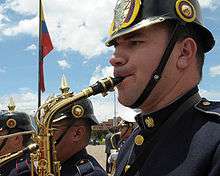
The Military Forces of Colombia and the National Police of Colombia sport military bands and drum and bugle corps with formations similar to those in the US, Italy, Germany and France (the latter shows signs of US and French influence).
Paraguay
Military bands are in service within the Armed Forces of Paraguay and the National Police of Paraguay, following the former Imperial German band pattern.
Brazil
Since the late 1940s the Brazilian Marine Pipes, Drum and Bugle Corps, using the above-mentioned brass and percussion instruments (plus bagpipes), represent both the Brazilian Marine Corps and the Brazilian Navy in all activities it participates. Its formation mirrors Portuguese and Italian military band traditions, as well as those of the US drum and bugle corps of the early 20th century. Other military bands include those of the Presidential Guard Battalion, the Independence Dragoons, and the Brazilian Air Force Academy Band. The PGB Band is the only band in the Brazilian Army to include both a pipe band section and a drum corps. (Personnel from the PGB Band form part of the newly formed Army Marching Band and Pipes and Drums, formed in 2016).
The Brazilian Marine Corps also fields for public duties the Brasilia Marine Corps Band and the Central Band of the Marine Corps.
Central and Eastern Europe
Romania
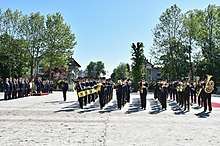
|
|
The Military Music Service of the Romanian Armed Forces (Serviciul militar militar al Forțelor Armate Române) and the Military Music Inspectorate (Inspectoratul Muzicilor Militare) are the principal military band departments in Ministry of National Defense of Romania. It is responsible for the organization and instruction of military bands in the armed forces. It is currently housed at a military base on 13 Iuliu Maniu Boulevard, Bucharest. July 1 is considered to be the "Day of Military Music" (Ziua muzicilor militare), which is observed as a professional holiday.[13]
In 1864, it became a special section in the Ministry of War, which controlled it's subordinate military bands and music schools. The section became the basis for the subsequent establishment of the Military Music Inspectorate in 1867, which had Captain Eduard Hübsch being the first commander. In the nearly 30 years since Hübsch was the inspector of the military music, the special regulations for the bands of the band were elaborated and the military musicians were given a new status in the army. On May 26, 1895, inspector general Ion Ivanovici (the author of the most famous Romanian waltzes Waves of the Danube) endowed the inspectorate with new instruments, introduced a valuable and diverse repertoire, while supporting the training of future military instrumentians. On October 10, 1936, the Military Music School was established, and was designed to ensure the training military music staff. In the middle of June in 1954, the representative military bands of each service branches of the Romanian People's Army were formed. The current inspector general of the military music service is Colonel Valentin Neacsu, who has served in this position since October 11, 2007, succeeding Colonel Ionel Croitoru.[14]
The military music service presides over the following Romanian military bands and institutions:
- Representative Central Band of the Romanian Army
- Representative Central Band of the Romanian Air Force
- Representative Central Band of the Romanian Navy
- Regimental Band of the Michael the Brave 30th Guards Brigade
- Military Training Center for Music
- Military Music School
Poland
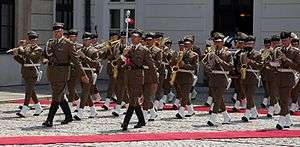
Polish Armed Forces military bands follow the Austrian model, but follow also the German and Russian band and march music tradition too. The main military band in Poland is the Representative Central Band of the Polish Armed Forces which is part of the 1st Guards Battalion, Representative Honor Guard Regiment and has served the leadership of Poland since 1918. All service branches of the armed forces also have their own military band.
Representative Band of the Border Guard
The history of the Representative Band of the Polish Border Guard (Orkiestra Reprezentacyjna Straży Granicznej) dates back to 1956 and is closely related to the history of the Carpathian Brigade of the Polish Army. It has performed its current functions as a military band since 1973 and has been based in Podhale since its founding. It is known as a perfect interpreter of symphonic, brass and classical music. The band prides itself on the over 10,000 concerts that it has performed over the years and the several prizes and awards it has been given by musical and government officials in Poland and abroad.[15][16]
Representative Band of the Navy
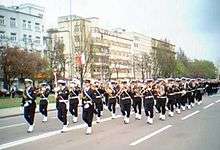
The Representative Band of the Navy of Poland (Orkiestra Reprezentacyjna Marynarki Wojennej Rzeczypospolitej Polskiej) serves the ceremonial and musical needs of the Polish Navy. The band was formed in 1920 in the city of Puck, which was the then headquarters of the Polish navy. It was transferred to Gdynia with other units in 1925, and has been based there ever since. It's activities were suspended during World War II due to the occupation of Poland. The Polish government created a Big Band as part of the band in 1982.[17]
Garrison Bands
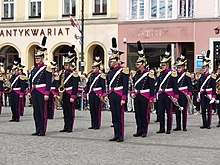
The following military garrisons have military bands under their jurisdiction:
Hungary
With the Hungarian Defense Forces Central Band of Music (HDF Band) (Magyar Honvédség Központi Zenekar) being the official military band of the Hungarian Defence Forces, it represents the HDF on every occasion, including parades as well as ceremonies and has done this since it's foundation in 1962. [20]
Caribbean
Given the long history of the military forces of the Caribbean, the military band heritage in this part of the world is a mix of various traditions. Bands assigned to military forces of Caribbean countries that are members of the Commonwealth of Nations generally follow the British pattern. Trinidad and Tobago takes this tradition a bit further with the use of steelpans in its bands. Only Haiti, with its French styled military bands, carries on the band tradition among the French-speaking countries of the region.
Cuba
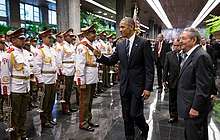
Since the late 1960s the tradition of the Cuban Revolutionary Armed Forces Band has been based mostly on the Russian tradition but also with a mix of the former American and Caribbean musical influence. The band has acclaimed high praise by many foreign leaders, including U.S President Barack Obama, who greeted bandleader Ney Miguel Milanes Gálvez and said that they did a "Good job" for their performance of The Star-Spangled Banner.[21]
Dominican Republic
Given the long history of the Armed Forces of the Dominican Republic, it is no surprise that the military band tradition is a mix of the French and US military band practice. Ceremonial bands are present not just in the Armed Forces but in the Dominican Republic National Police.
Post-Soviet military bands
Russia
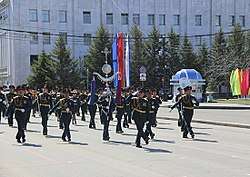
In the days of the Imperial Russian Armed Forces, military bands followed the German style of military bands, with the addition of the chromatic fanfare trumpet. Some but not all Russian marches then were made in Germany and other locations as the rest were locally composed military marches. They would usually have a conductor, and a drum major using his mace with/or a bugle major playing the chromatic fanfare trumpet. Brass instruments formed the first tier of the formation followed by the percussion and the woodwinds. Mounted cavalry bands were similar to German ones but were different in many aspects.
Military bands (also loosely translated to Военный оркестр, which means Military Orchestra) when massed would add field drums and fanfare trumpets to the ensemble for large parades and state ceremonies. The formation used by these massed bands mirror today's formations.
By the time that the Soviet Armed Forces came into being in 1918, military bands began to change for the better. With the establishment of the Central Military Band by Semyon Chernetsky in 1927 came the birth of today's Russian and ex-Soviet Union military band culture. In the late 1920s and the 1930s the typical Soviet Massed military bands that perform on May 1, November 7 and from 1945 onward, May 9, would be composed of a Military band and a Corps of Drums marching past and until the 1970s would later join the military band in place.
Soviet massed military bands in the 1930s and 1940s tend to have a drum major, a conductor and an optional two to three deputy conductors in the front of the band. Mounted bands had the same formation, but with only a director of music and the optional mounted band drum major, only few bands sported woodwinds.
The Soviet military bands of the pre-war days played not only on May Day and Revolution Day, but in the National Sports Day parades at the Red Square, the various sports competitions and other occasions and after the Second World War, at Victory Day celebrations across the USSR. In the 1930s, the Turkish crescent holders were shaking during the sports parades, but in the 1940s, they were not shaking them. Their formation mirrored those used by Russian military bands in the Imperial era.
By the 1950s, Soviet military bands evolved in instrumentation. Their positioning, especially in the Moscow bands, changed for the better as newly composed Soviet military marches soon created the Soviet military band sound common to Westerners during the Cold War days. A conductor and one to four drum majors and several bandmasters led the massed military bands of the Soviet Union in Moscow, Leningrad and republican capital cities into a new decade of progress for Soviet military music as many new compositions entered the songlist of marches played during state parades. The reform of the bands begun in 1948-1949 under the assistant director of the band service, Major General Ivan Petrov, and continued on until the 1970s.
Ukraine
Military bands in Ukraine are subordinated to the Military Music Department of the General Staff of the Ukrainian Armed Forces:[22][23]
- National Exemplary Band of the Armed Forces of Ukraine
- Band of the Kiev Presidential Honor Guard Battalion
- Military Music Center of the Ukrainian Ground Forces
- HQ Band of the Military Music Center Ukrainian Ground Forces
- Band of the Western Operational Command
- Band of the Northern Operational Command
- Band of the Southern Operational Command
- Military Music Center of the Ukrainian Air Force
- Military Music Center of the Ukrainian Navy
- Band of the Odessa National Maritime Academy - Ukrainian Naval College of Odessa
- Mykolaiv Navy Band
- Marine Division Band
- Military Band of the National Defense University
- Military Band of the Hetman Petro Sahaidachnyi National Ground Forces Academy
- Military Band of the Ivan Kozhedub National Air Force University
- Military Band of the Military Institute of Telecommunications and Information Technologies
- Military Band of the Ivan Bohun Military High School
- Military Band Service of the National Guard of Ukraine
- Central Band of the National Guard of Ukraine
- Band of the National Guard Military Academy of Ukraine
- Band of the NGU National Honor Guard Battalion Kiev
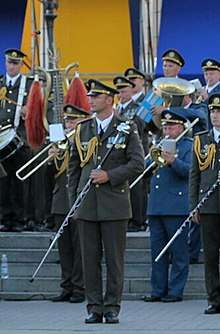
Since the Russian Army annexed Crimea in 2014 followed by the War in Donbass, Ukrainian military bands have been ordered to orient their marching styles, as well as their drum majors to military bands in the European Union and NATO armed services.
Belarus
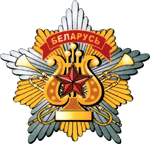
The massed bands of the Military Band Service of the Armed Forces of the Republic of Belarus (also known as the Central Band of the Armed Forces of the Republic of Belarus) follow the Russian traditional model with elements of Belarusian music in its repertoire. Regional bands from each of the military commandants form the basis of the central band along with the Exemplary Band, the Band of the Honor Guard Battalion, and the Central Band of the Interior Ministry. The bands of the regional departments of the Ministry of Internal Affairs are also affiliated to the band as well.
Kazakhstan
The Presidential Orchestra of the State Security Service of the Republic of Kazakhstan is a military music unit made for state ceremonies carried out by the State Security Service of Kazakhstan.[24] Military bands are also maintained in the Ministry of Defense and the National Guard.
Tajikistan
The Military Brass Band of the Commandant Regiment of the Ministry of Defense of Tajikistan follow the Russian precedent for military bands while adding traditional Central Asian instruments such as the Karnay.
Moldova
Military bands of Moldova fall under the command of the music service of the Moldovan National Army, which is currently under the leadership of Major Sergiu Holban and Major Veaceslav Veste. These bands follow the Russian and Romanian military tradition for military bands. The military bands of the army have performed and participated in international music festivals since 1997. The military bands of the National Army's Chisinau Garrison include:[25]
- The Presidential Orchestra of the Republic of Moldova
- Bands of Motorized Infantry Brigades
- The Band of the 1st Motorized Infantry Brigade
- The Band of the 2nd Motorized Infantry Brigade
- The Band of the 3rd Motorized Infantry Brigade
- Central Military Band of the Ministry of Internal Affairs of Moldova
- Central Band of the Border Police
Southeast Asia
Thailand
Inspired by British military bands, military bands in Thailand play uniquely Thai military marches. Especially during the Trooping of the Colours ceremonies in Bangkok every December 2 since 1953, Royal Thai Armed Forces military bands perform at every military function attended by the Royal Family and other military officers and local executives, together with the general public.
Thai military bands' formations closely follow either that of the Royal Marines Band Service, being that the percussion are at the front rather than the middle, followed by the main band itself or that of the British Army's Household Division Foot Guards Bands, being that the percussion are at the middle of the main band. But another formation followed is that of the Brazilian military bands, wherein the percussion are in front of the brass and winds, with the bass drums as the lead instruments. These bands are led by a Drum Major and the Director of Music.
Myanmar
Band formations in the Tatmadaw follow the former British pattern, especially of the bands of the Royal Marines Band Service and the former Royal Navy bands. The Central Military Band of the Myanmar Armed Forces was formed on November 30, 1988 in the Hmawbi Township of the Yangon Region. The current director of music of the band is Lieutenant Colonel Min Thant Zaw, with the bandmaster being Warrant Officer Thet Naing Soe.[26] The 240-member Myanmar Police Force Band, which is the country's oldest brass band (it was formed in 1945), also serves as a type of military band.[27]
Indonesia
The modern Indonesian military band tradition includes Japanese, Dutch, British and United States influences. Known locally as Ceremonial Bands (Korps Musik Upacara/Satuan Musik Upacara/Detasmen Musik Upacara), they form part of the Indonesian National Armed Forces. Similar ceremonial bands are maintained by the Indonesian National Police. Indonesia also maintains a "corps of drums" tradition. Such ceremonial units are also part of the Dutch colonial legacy, as both the Royal Netherlands East Indies Army and the Royal Netherlands Navy included similar formations before independence.
Singapore
With inspiration mainly coming from British, Chinese, and Malaysian military bands, the Singapore Armed Forces Band form the Singapore Armed Forces musical arm, which plays a vital role in parades and ceremonies such as the NDP.
Vietnam
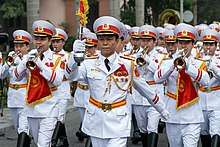
Modern military bands that are part of the Vietnam People's Army are heavily influenced and inspired by military bands in Russia and China.
Korea
Military band formations differ in the two Korean countries' armed forces.
Democratic People's Republic of Korea
.jpg)
The bands of the Korean People's Army and the Korean People's Security Forces follow the general instrumental setup of Daechwitas, the Korean traditional military bands.
Republic of Korea
.jpg)
Although patterned after American and British military bands, the bands of the Republic of Korea are also inspired by the daechiwtas of the old Korean kingdoms. Their formation mirrors US and British military band formations. The Republic of Korea Army maintains a Traditional Band playing in the daechiwta styles of old, using Korean traditional musical instruments.
China and Taiwan
Chinese military bands both in the mainland, Hong Kong, Macau and Taiwan play a mix of foreign and native marches and musical pieces.
During the Boxer Rebellion, the xenophobic Chinese General Dong Fuxiang who commanded the Muslim Kansu Braves, refused to allow his troops to play western musical instruments, making them play traditional Chinese instruments such as the Sheng Jia.[28]
Hong Kong SAR
Military style bands in Hong Kong (save the Band of the PLA HK Garrison), although now playing Chinese and international marches, still retain British and Commonwealth influences. A band formation modeled on that of the British Army is one such tradition, as is the use of pipe bands. Only one band affiliated to the Sea Cadets follows the RN pattern.
The Hong Kong Police Band in the Hong Kong Police provides similar function to a military band.
Macau SAR
The Macau Security Force maintain a military style band which reflects the region's Portuguese military traditions.
People's Republic of China
.jpg)
Although inspired by Soviet military music throughout their history, the military bands of the People's Republic of China (either belonging to the People's Liberation Army or the People's Armed Police) play indigenous and locally composed military marches, during official ceremonies and other events as called for.
Republic of China (Taiwan)
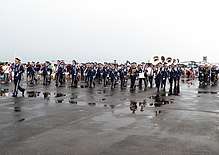
Military bands of the R.O.C. can trace their origins to the 1911 revolution. Existing units including the Symphonic Band and Orchestra of the Ministry of National Defense, the Army Band, the Navy Band, and the Air Force Band.[29] All these bands are inspired by American and German military band traditions, and their formation mirrors those used by US bands. Taiwan also has a great military drum and bugle corps tradition as well with a few military DBCs in active service, with their formations not quite similar to US corps plus corps style marching bands in the Armed Forces Preparatory School and the ROC Army Academy.
Japan
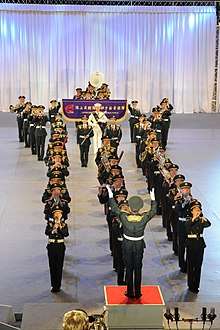
The Western military band tradition arrived in Japan during the Meiji Restoration, which saw the armed forces reformed to the standards of Western armed services. Today, the Japan Self-Defense Force sports a moderate number of military bands within all its service branches (The Ground, Maritime and Air Self-Defense Forces) which carry on a long heritage of Japanese military music beginning in the 1880s. The JSDF also carry on the Imperial practice of bugle call playing, which dedicated bugle platoons present in almost every unit using G major bugles similar to those used by the United States Army in the past.
Japanese military bands have a number of formations, modeled on those in the US and UK, and they are led by Drum Majors, Conductors and Bandmasters, while the bugle platoons are led on parades by a Bugle Major.
Sweden
Traditionally, every Swedish regiment had a band. During the 20th century many of them were disbanded and in 1957 all remaining military bands were merged into one per garrison or disbanded entirely. The Swedish military music was made into a non-military organization in 1971 but this proving unsuccessful, the Royal Swedish Army Band was set up in 1982, followed by several other bands in the 1990s. As of 2010 the Swedish Armed Forces no longer have conscripts, but professional soldiers. The military musicians in the Swedish Armed Forces Music are now professional musicians with civil ranks (CR-1/8) or professional soldiers with military ranks (OR-1/5). Today, Swedish military music has undergone new cuts, retaining two bands only in the army and one in the navy and only a single field music formation. In addition there are 26 bands in the Swedish Home Guard.
Formations in these bands are a mix of the Italian, German and British band traditions.
Active bands of the Swedish Armed Forces Music
- A: Arméns musikkår (AMK) - Royal Swedish Army Band - Stockholm
- A: Livgardets dragonmusikkår (LDK) - Life Guards' Dragoon Music Corps - Stockholm
- N: Marinens musikkår (MMK) - Royal Swedish Navy Band - Karlskrona
Photographs
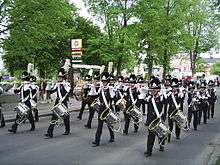 Royal Swedish Army Drum Corps (discontinued in 2009)
Royal Swedish Army Drum Corps (discontinued in 2009)

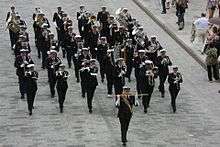 Uppsala Home Guard Band (Hemvärnets Musikkår Uppsala, HVMK Uppsala)
Uppsala Home Guard Band (Hemvärnets Musikkår Uppsala, HVMK Uppsala)
Netherlands and Belgium
A strong military band presence is evident in the armed services of the Netherlands and Belgium. Bands of the Armed forces of the Netherlands and the Belgian Armed Forces sport formations similar to those used in the UK and France.
Images
 The Trumpeter
The Trumpeter A military band from the Union Army during the American Civil War.
A military band from the Union Army during the American Civil War.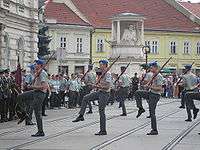
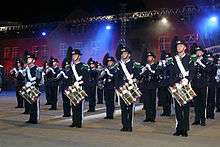 Norwegian Royal Guards Company Three, Music Platoon
Norwegian Royal Guards Company Three, Music Platoon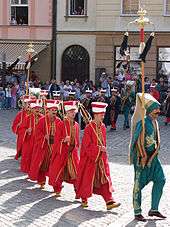
 Polish Navy Orchestra
Polish Navy Orchestra- Brazilian Marines band at the 2005 Bastille Day Military Parade
 Royal Military College of Canada Military band centennial album 1975
Royal Military College of Canada Military band centennial album 1975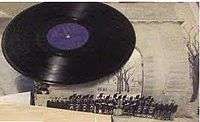 Royal Military College of Canada Military band album
Royal Military College of Canada Military band album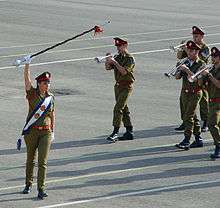 Israeli military band drum major with baton
Israeli military band drum major with baton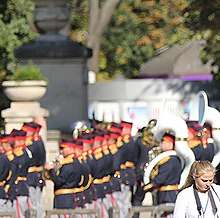 Moldovan Military Band
Moldovan Military Band Romanian Military Band
Romanian Military Band
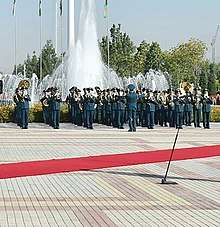

See also
| Wikimedia Commons has media related to Military bands. |
- Bandmaster
- Brass band
- Bugle
- Concert band
- Corps of Drums
- Drum and bugle corps
- Fanfare band
- March (music)
- Martial music
- Marching band
- Military parade
- Military tattoo
- Ottoman military band (considered to be the oldest type of military marching band in the world)
- Parade
- Pipe band
- Police band (music)
- Ruffles and flourishes
Notes
- ↑ Turkish Cultural Foundation. "Military (mehter)". Retrieved 2013-08-09.
- ↑ "Mehter-The Oldest Band in the World". Tsk.tr. Archived from the original on 2014-01-01. Retrieved 2014-05-21.
- ↑ "A History of the Wind Band: The Baroque Wind Band". Lipscomb.edu. Retrieved 2014-05-21.
- ↑ "Ottoman". Theottomans.org. Retrieved 2014-05-21.
- ↑ "Mehter Music Echoes Down The Centuries". Saudi Aramco World. Retrieved 2014-05-21.
- ↑ "Project MUSE - The impact of Turkish military bands on European court festivals in the 17th and 18th centuries". Muse.jhu.edu. Retrieved 2014-05-21.
- ↑ Major R.M. Barnes, page 231 "A History of the Regiments & Uniforms of the British Army", Sphere Books 1972
- ↑ "Military Music in American and European Traditions | Thematic Essay | Heilbrunn Timeline of Art History | The Metropolitan Museum of Art". Metmuseum.org. Retrieved 2014-05-21.
- ↑ "Bands of the corps". Ministry of Defence. Retrieved 2014-05-10.
- ↑ "Reserve Bands". Ministry of Defence. Retrieved 2014-05-10.
- ↑ FAM 2020
- ↑ Archived July 24, 2011, at the Wayback Machine.
- ↑ https://www.agerpres.ro/flux-documentare/2017/07/01/ziua-muzicilor-militare-03-40-53
- ↑ http://www.mapn.ro/cpresa/continuarearhiva.php?id=3067
- ↑ http://www.orkiestra.strazgraniczna.pl/ork/orkiestra/13883,Orkiestra-Reprezentacyjna-Strazy-Granicznej.html
- ↑ https://forsvaret.no/kultur/musikk/the-representative-band-of-the-boarder-guard-of-the-republic-of-poland
- ↑ http://www.mw.mil.pl/index.php?akcja=orkiestryrepr
- ↑ http://owbydgoszcz.wp.mil.pl/pl/2.html
- ↑ http://www.csaiu.torun.pl/dg/orkiestra.aspx
- ↑ http://bhd.honvedseg.hu/rovat/kozponti_zenekar
- ↑ "Obama Visits Cuba". Retrieved 2018-10-07.
- ↑ "Військово-музичне управління Збройних сил України | Міністерство оборони України". archive.today. Retrieved 2018-09-25.
- ↑ "Положення про військово-музичні підрозділи Збройних Сил України". Законодавство України (in Ukrainian). Retrieved 2018-02-04.
- ↑ "Kazakhstan: the President's Band includes a brass section, chamber music bands, song and folk dance ensembles".
- ↑ "Ministry of Defense of Republic of Moldova". army.md. Retrieved 2018-09-25.
- ↑ https://spasstower.ru/en/participants/orkestr-vooruzhennykh-sil-myanmy/
- ↑ https://www.mmtimes.com/news/myanmars-oldest-band.html
- ↑ Lanxin Xiang (2003). The origins of the Boxer War: a multinational study. Psychology Press. p. 207. ISBN 0-7007-1563-0. Retrieved 2010-06-28. scroll down to next page from 206 to get to 208
- ↑ Chou, Shih-Wen. "陸軍軍樂隊 (Army Military Band)". Taiwanpedia. Archived from the original on 2012-04-05. Retrieved 2011-11-27.
- CWO (Ret`d) Jack Kopstein CD ` When the Band Begins to Play: A History of Military Music in Canada (1992).
- CWO (Ret`d) Jack Kopstein CD & Ian Pearson `The Heritage of Military Music in Canada` (St. Catharines, Ont.: Vanwell Pub., 2002)
- CWO (Ret`d) Jack Kopstein CD & Ian Pearson `The History of the Marches in Canada: Regimental/Branch/Corps` (Hignell Printing Ltd, 1994).
External links
- Military Music in American and European Traditions, Heilbrunn Timeline of Art History, The Metropolitan Museum of Art
- (in Russian) Brassmusic.Ru Russian Brass Community
- Brandenburg Historica (C) 2014. "Military Music and Tradition in Imperial Russia, 1700-1918". Updated August 22, 2014.
- (in German) German Military Music
- The International Military Music Society (IMMS)
- www.militarytattoo.org − Information Website
- Brandenburg Historica (2005). "Gott, Kaiser, Vaterland: Military and Patriotic Music of Imperial Germany, 1903-1915". Updated January 27, 2008.
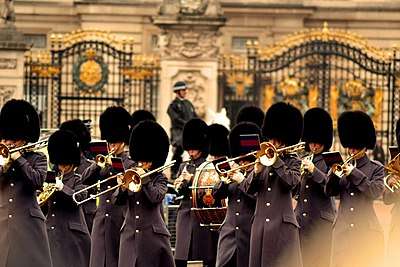
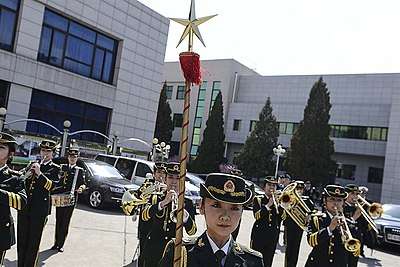
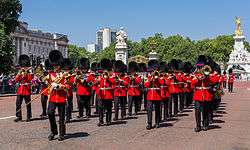
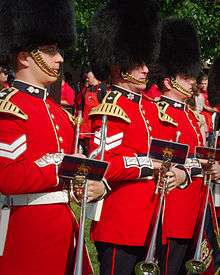
.jpg)
